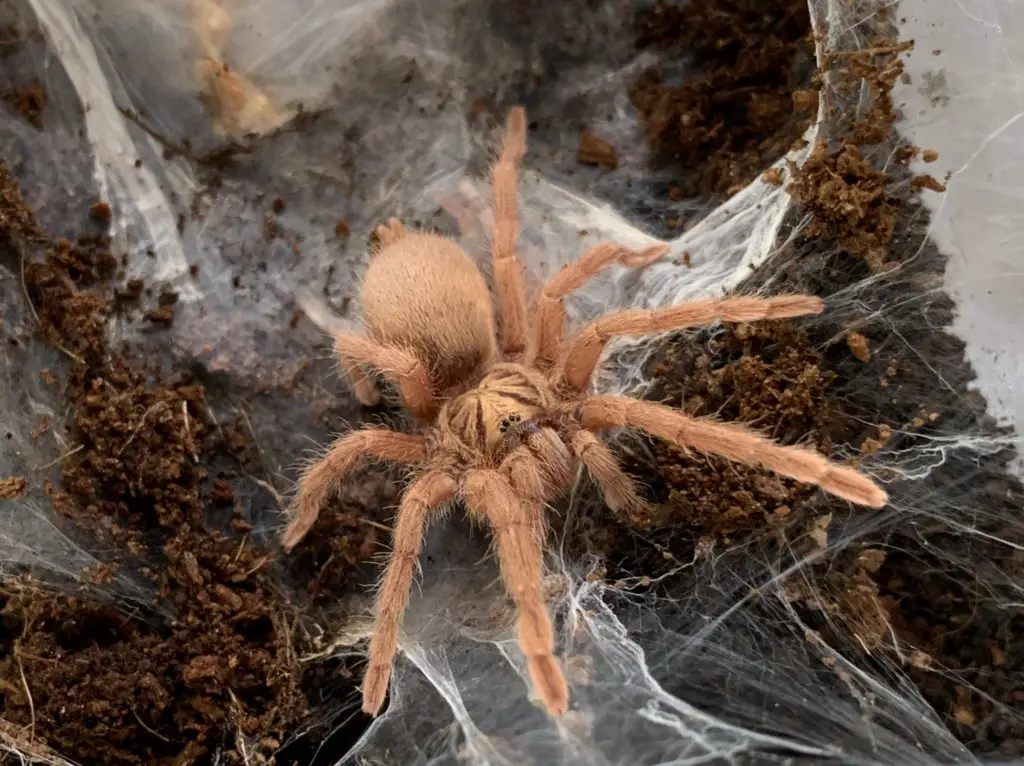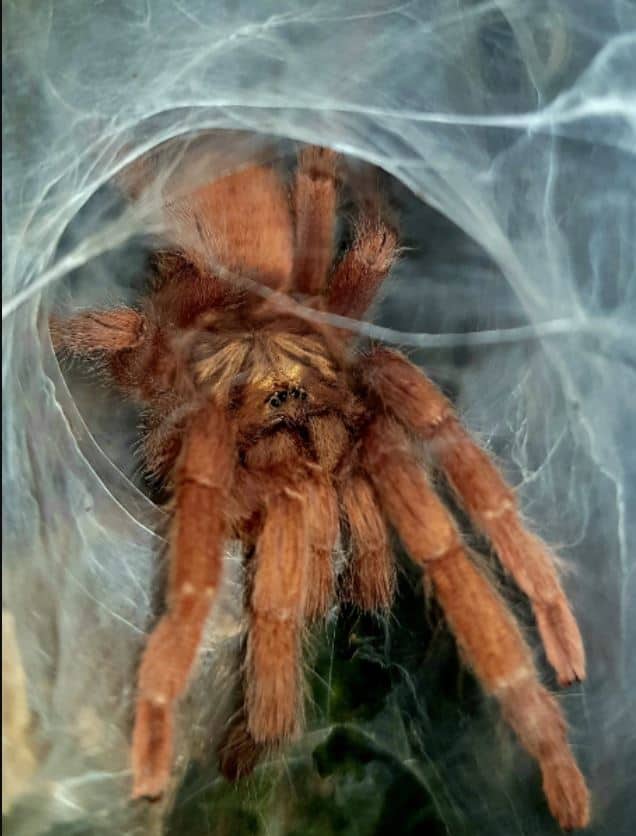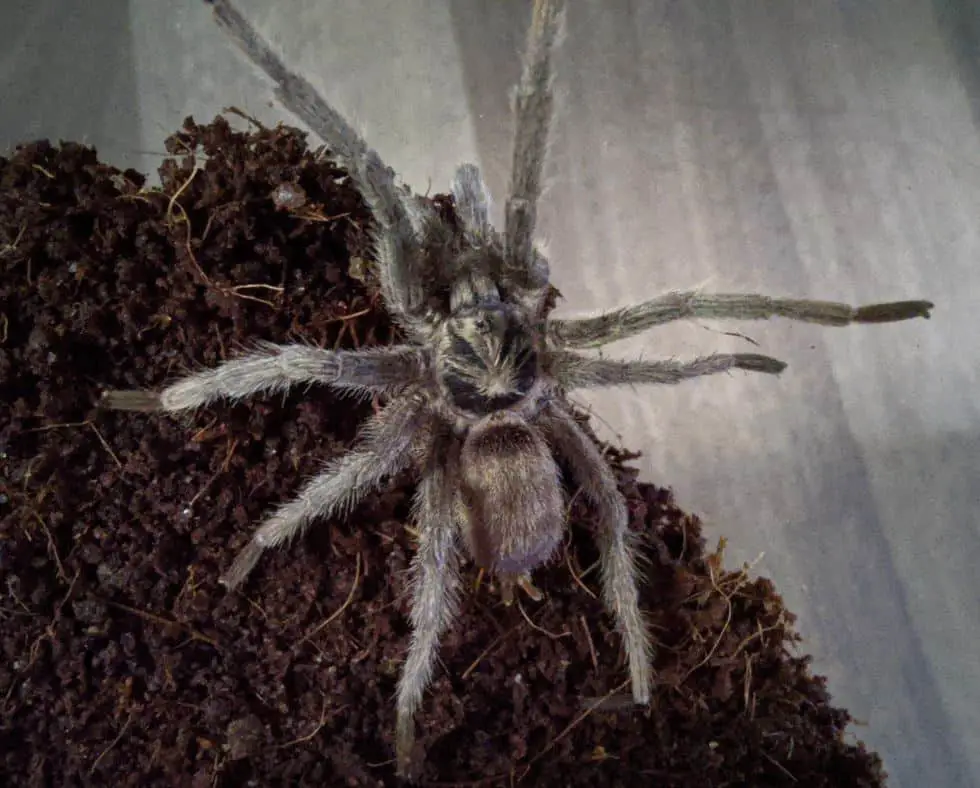The Trinidad Olive Tarantula is a New World Terrestrial species that is native to Trinidad and Venezuela. The species is very popular amongst hobbyists due to its relaxed behavior, beautiful coloration, and small size.
One of its most appealing and unique traits is its capacity to live communally, meaning that you can house more than one of these spiders in the same enclosure.
If this beautiful tarantula has caught your attention and you’re considering adding one to your collection, here’s everything you need to know.

Trinidad Olive Tarantula Care Sheet
| Species Name | Neoholothele incei |
| Family Name | Theraphosidae |
| Common Names | Trinidad Olive Tarantula |
| Category | New World |
| Type | Terrestrial burrower |
| Native Location | Trinidad, Caribbean, Venezuela |
| Body length | 1.5 inches (4 cm) |
| Leg Span | 3 inches (7.5 cm) |
| Growth Speed | Fast |
| Urticating Hairs | No |
| Social | Communal living possible |
| Diet | Crickets, roaches, mealworms |
| Temperature | 70 to 80 degrees Fahrenheit |
| Humidity | 70 to 80% |
| Lifespan | Female: 6 to 7 years / Male: 1 to 2 years |
| Experience required | Intermediate |
| Minimum tank size | At least 12″ x 12″ x 12″ for a single tarantula |
Trinidad Olive Tarantula Overview
The Neoholothele incei, previously known as Hapalopus incei, is a magnificent dwarf species.
Commonly known as the Trinidad Olive Tarantula, it grows no larger than 3 inches.
One of the most interesting facts about this species is that the Trinidad Olive Tarantula is able to live communally with members of its own species both in the wild and in captivity.
Known for being really fast and skittish, and considering the possibility of communal enclosures, it’s not recommended as a first tarantula and is better suited to hobbyists that have some experience caring for tarantulas already.
Appearance & Variants

The Trinidad Olive Tarantula has a beautiful golden color in a unique pattern. She has really short hair exhibiting a brown-colored body with dark brown and yellow markings on her legs and carapace, with horizontal stripes across her abdomen.
These spiders exhibit sexual dimorphism, so the females are different from the males. The males are smaller and are often more grayish, while females tend to have a brighter yellow pattern similar to gold.
The Trinidad Olive Tarantula also has a gold variant with a more distinctive golden coloration in both males and females. However, for these spiders, it’s usually the case that males are golden while females are grayish.
This golden coloration is caused by a rare recessive trait.
Price
The price of a Trinidad Olive Tarantula depends on whether it’s a male or a female. As happens with most tarantulas, females are more expensive due to their much longer lifespan.
However, they’re quite cheap due to their generally short lifespan and high availability.
A spiderling can be bought for around $30. Adult males aren’t much more expensive and can be found for as low as $50.
Adult females are the most expensive specimens and will rise slightly to $75, or even up to $100 in some cases.
Behavior and Temperament
The Trinidad Olive Tarantula is known for its capability to stay in a communal environment. Several spiders can live in the same enclosure as long as there is enough food to prevent cannibalism.
Their behavior is shy and skittish. They’ll throw up a threat pose if they feel frightened and cornered, but their first instinct will always be to flee.
Even though they rarely bite, in the few cases where they do end up biting someone, the recipients of those bites report no more than mild burning at the place of impact.
This suggests that despite the fact that they lack urticating hair, they do not have very potent venom.
This tarantula will create a very interesting and beautiful web complex, especially when kept communally.
They’ll make tunnels in which they’ll spend most of their time waiting for prey, catching it with an amazing speed.
Due to their fast and erratic movement, it’s essential to keep an eye on them while rehousing and opening the hatch to feed them.
Their temperament makes them well suited for intermediate hobbyists.
Caring for a Trinidad Olive Tarantula

Trinidad Olive Tarantulas are not particularly difficult to care for. The most important information that you need to know is about their tank setup, temperature & humidity requirements, social behavior, and food. Let’s take a closer look at each of these aspects.
Temperature and Humidity
In the wild, the Trinidad Olive Tarantula lives in a tropical, humid, and warm area. Temperatures reach up to 86°F with high humidity almost every day.
Be aware that this spider will protect itself against the burning sun underneath tree trunks, branches, leaves, and abandoned burrows.
Do not overheat the terrarium. It’s advisable to have them in captivity in an environment around 77-82°F (day), 70-77°F (night), and 70-80% humidity.
Substrate
The Trinidad Olive Tarantula is a terrestrial species. The standard terrestrial tarantula enclosure gives more importance to floor space than height and provides plenty of substrate for burrowing.
Spiderlings should get at least three inches of substrate, and both juveniles and adults should have four inches as a minimum.
They need a moisture-retaining substrate on the enclosure’s mixture, such as coconut fiber. This provides a soft base for burrowing, in addition to keeping the enclosure clean and humid.
Other good materials include vermiculite, peat moss, or a mixture of the three.
Tank Setup
If you’re looking to have a single specimen, you can opt for a smaller enclosure with 12″ x 12″ x 12″ dimensions.
Of course, a communal enclosure needs to be larger so the spiders don’t feel cramped. In this case, going for an 18″ x 18″ x 12″ terrarium is recommended.
The inside of the enclosure also needs a few considerations. However, the Trinidad Olive Tarantula generally needs fewer accessories than most other tarantulas due to their intricate web systems.
A piece of cork bark is a great place for the tarantula to hide in when they feel stressed/threatened; other than that, you won’t be needing any other accessory though you can choose to place a few natural rocks and artificial plants to spice up their home a bit.
You must also ensure that they have enough ventilation in their enclosure.
Watering
The Trinidad Olive Tarantula lives in a climate where it rains and is humid for around eight months every year.
They’re used to moist floors, so you should spray the substrate with water at least once a week.
You should still give them a water dish and refill it when it’s empty. It prevents dehydration while also contributing to the enclosure’s humidity.
Slings that are too small to drink from a bowl will drink droplets that you can drip down the sides of the enclosure.
Social
The Trinidad Olive Tarantula is one of those rare species that’s capable of communal living. What this means is that you can house multiple of them in the same enclosure. However, there are a few precautions that you must take to ensure that this goes well.
First, make sure that they have enough space. If they do not have enough space they can become aggressive and agitated toward one another.
Secondly, make sure that they always have enough food. If they feel that they do not have enough to eat they might resort to cannibalism.
Diet and Feeding
The Trinidad Olive Tarantula is a relatively small spider that doesn’t need as much feeding as most other species.
As spiderlings, they should be offered a flightless fruit fly or a pinhead cricket as frequently as it’s willing to eat, usually around two to three times per week.
Juveniles can eat a medium cricket about twice a week, and adults can eat around three large crickets weekly.
As long as they receive a steady food supply in communal enclosures, they rarely resort to cannibalism.
Health & Lifespan
Trinidad Olive Tarantulas do not live as long as many other species. Typically, females live for about 6 to 7 years while males only live for 1 to 2 years.
In captivity, they can easily live their entire lifespan until they die of natural causes. The only real problems that they can face in captivity are spider mites, mold, parasites, falls, and if they’re kept communally, other members of their species.
Luckily, these problems are quite easy to prevent. Make sure that you always keep their enclosure clean, remove uneaten food, and replace their water frequently. Also, do not handle them and do not place them in an enclosure that’s too tall to prevent falls.
Fun Facts about the Trinidad Olive Tarantula
- The Trinidad Olive Tarantulas’s name has Greek roots that are somewhat ambiguous, like “New complete strength” or “new complete energy”. It’s possible that incei refers to a person or a place.
- This is one of the few species that comes in two entirely distinct color forms. It has a gold form and an olive form, and you can get both in the same egg sac.
- Due to their stripes pattern brought together by a “Bumble Bee” pattern on the abdomen, some hobbyists give these the nickname “Bumble Bee Tarantula”.
- The Trinidad Olive Tarantula doesn’t have urticating hairs even though they are a New World Species.
Final words: Is the Trinidad Olive Tarantula right for you?
If you’re looking for a species that’s beautiful, small, and capable of communal living, the Trinidad Olive Tarantula might be right up your alley.
They’re not too suitable for beginners due to their temperament, but intermediate hobbyists could definitely consider adding this species to their collection!
- How Long Do American Eskimo Dogs Live? Important Factors and Care Tips - September 29, 2023
- Do American Bulldogs Need Grooming? Essential Tips and Care Guidelines - September 29, 2023
- Do Bengal Cats Enjoy Playing? Essential Tips for Keeping Them Active - September 29, 2023